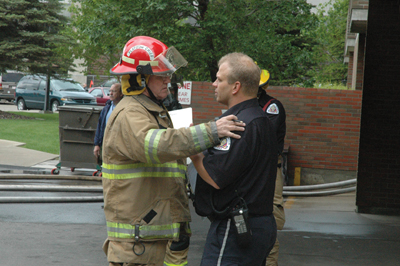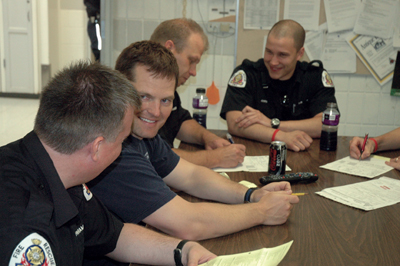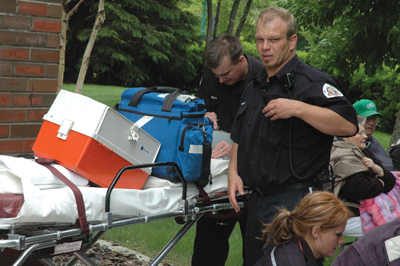
Features
Hot topics
Response
Simultaneous response
Six minutes. That’s the span between cardiac arrest and the start of irreversible brain death. Firefighters and paramedics know this. But given the complicated dispatch systems and the tiered and varied response protocols for fire and EMS across Canada, it’s clear that many politicians, administrators and taxpayers don’t understand it.
June 19, 2009
By
Laura King
Six minutes. That’s the span between cardiac arrest and the start of irreversible brain death. Firefighters and paramedics know this. But given the complicated dispatch systems and the tiered and varied response protocols for fire and EMS across Canada, it’s clear that many politicians, administrators and taxpayers don’t understand it.
 |
|
| Lethbridge’s integrated fire/EMS, which began in 1912, has proven effective with all firefighters trained as paramedics. Platoon Chief Bill Mellafont confers with firefighter/paramedic on scene during a fire at a high-rise last summer. Photo by Laura King
|
The Ontario Association of Fire Chiefs is trying to change that. At its annual conference in May, Fire Chief Shayne Mintz, chair of the OAFC Pre-Hospital Care Committee, spoke clearly and passionately about the flaws in – and politics of – Ontario’s Central Ambulance Communication Centres (CACCs – pronounced “kacks”) dispatch system and the need for a new protocol that embraces the superior response capabilities of the fire service.
The OAFC’s pre-hospital care committee has spent more than two years researching fire and EMS response times and the benefits of a combined service. Now, despite some anticipated opposition from EMS, the OAFC is lobbying the provincial government for a more cohesive fire/EMS system, following the lead of jurisdictions such as Winnipeg, Lethbridge, Alta., and Seattle, Wash.
“The mission of Ontario’s fire services is to protect and save lives and property,” says OAFC president and Oakville Fire Chief Richard Boyes. “There are no conflicting agendas.”
Indeed, increased use of the Winnipeg fire service for EMS calls has cut response time in half to 4.5 minutes and is expected to save 10,000 ambulance calls in one year and $8.5 million. In Lethbridge, which has had integrated fire/EMS since 1912, all firefighters are trained paramedics who may ride an ambulance one day and a pumper the next.
“Irreversible brain death starts six minutes after circulation stops,” Mintz told the Ontario chiefs convention. “We have a system that can help avert that.”
The gist of the problem in Ontario is that many fire departments are not being dispatched by the CACCs or they’re being dispatched significantly later than EMS. (The Ontario Ministry of Health and Long-Term Care operates 11 CACCs; five others are operated by hospitals and there are four local ambulance communications services in the province.)
In a video on the merits of a fire/EMS response system shown to OAFC delegates, proponents of a strengthened fire/EMS system noted that:
- Firefighters cross trained as EMTs and paramedics can deliver similar care as paramedics;
- Firefighters can and have received 1,200 to 1,800 hours of training to become paramedics;
- Firefighters will always be the front line;
- Firefighters can perform in ways that are patient centred and that single-role paramedics can’t – they can handle an entire incident from an extrication to an elevator rescue because they have different equipment, skill sets and authorities than paramedics.
Lethbridge firefighter/paramedic Dana Terry outlines his city’s program on the video.
“What we see is the built-in efficiency of joint disciplines who are able to come as one and treat the patients. What it comes down to is patient treatment. It provides an efficiency for the city…”
In the U.S. the International Association of Fire Fighters and the International Association of Fire Chiefs are embracing combined fire/EMS system and a national lobby group, Fire Service-Based EMS Advocates, is raising awareness of the benefits of fire-based EMS.
In Ontario, Boyes, Mintz and others have made it clear that the OAFC supports EMS ambulance services and paramedics but they note that some EMS budgets in Ontario have increased considerably over the last few years yet two-thirds of EMS services still fail to meet prescribed response times.
“It’s not about the EMS people, they’re doing a great job,” Mintz said during the OAFC presentation. “It’s about the lack of us [firefighters] being made aware when we can provide patient centred, lifesaving help to those in urgent need.”
“The EMS skills and abilities are all there – we’re not trying to take over EMS here. This is about citizen and patient centred services that, with timely notification from the ambulance dispatch centres will get the quickest response to citizens in need.”
Fire departments in many Ontario communities were approached in 1995 (or earlier) by the health-care community to come help with emergency assistance; that’s when defibrillators were put on fire trucks.
“Lives are needlessly at risk,” says Mintz. “The current approach is not working. There are people collapsing in the streets needing urgent care.”
Mintz said he’s received letters from people thanking the fire service for arriving quickly to emergency medical calls. One was from a paramedic noting that the fire response time was excellent and crucial to a patient who had collapsed while shovelling snow.
“That’s because in most cases we can get there in six minutes or less, so that’s where we need to be stepping forward and saying, ‘Hey, call us’. No one wants to see their mother or father collapsing at the end of the driveway and needlessly waiting for help because there’s a policy that says the EMS shows up first.”
Mintz says politicians and taxpayers should consider the fire service a health-care partner given that its members have been doing CPR and defibrillation for more than a decade.
 |
|
| Lethbridge firefighters/paramedics Scott Lane, Chris Carney, Randy Crow and Chris Tomaras handle paperwork after an afternoon fire and other incidents. Photo by Laura King
|
The fact is that fire trucks and firefighters trained in life saving and strategically located in municipalities for rapid responses can get to accident scenes or medical calls faster than paramedics and ambulances, the OAFC says.
A November 2008 discussion paper on pre-hospital care by the OAFC and the Ontario Professional Fire Fighters Association, called Saving Lives in 6.0 Minutes or Less by Utilizing the Efficiencies of the Ontario Fire Service, points out the 2005 Ontario auditor general’s findings that says ambulance response times average 13.1 minutes for life-threatening emergencies and notes that standalone EMS providers seem to be having difficulty bettering these times.
“Ontario’s fire services have the ability to respond effectively and quickly to all hazards; fires, motor vehicle accidents, hazmat/chemical, biological, radiological and nuclear (CBRN) incidents, terrorists attacks and yes, with existing medical skills, life threatening medical calls such as cardiac arrest,” the discussion paper says.
“In many cases, patients only require immediate life saving treatment, but they may also require physical rescue, protection from the elements and protection in the way of scene safety. The fire service is structured to address all of the above simultaneously and is perfectly positioned to complement and enhance a struggling EMS delivery system across Ontario, thus significantly improving patient outcomes.”
Getting back to those six crucial minutes after cardiac arrest: obviously, the sooner the patient receives CPR and/or defibrillation, the greater the probability of survival.
According to the OAFC, the average response time for the fire service, as reported by the Ontario Fire Marshal, is six minutes. That means the average response time in many urban areas is less than six minutes. That’s less than half of the average 13.1-minute response time for EMS in Ontario. The chance of successful resuscitation is reduced by between seven per cent and 10 per cent for each minute of delay in intervention.
“Dispatching fire and EMS simultaneously would better ensure that Ontarians receive prompt and trained emergency medical response when they need it most,” the association says.
Indeed, the OPFFA and the OAFC say they have heard many accounts of ambulances with lights and sirens speeding past a fire hall several minutes before the fire department received a call from the ambulance dispatch centre to respond to the same incident.
Hence, the OAFC argument: “Failure to call the community fire department simultaneously, despite existing agreements to do so, compromises the public well being and severely hampers the fire service’s ability to provide rapid and effective emergency response. While not only being a frustrating situation for both the public and for firefighters this could also have a significant impact on patient outcome.”
Indeed, Ontario’s 2005 auditor general’s report noted that two-thirds of ambulance operators were not meeting legislated response times yet the cost of the service increased by 94 per cent over four years. More funding was provided between 2005 and 2007 with no change to overall ambulance response times.
“This clearly demonstrates the current model isn’t effective, and that the current approach to fixing it isn’t working either,” the OAFC says. “We must look at other alternatives within our existing resources to create a truly patient centred system. The best way to reduce response times is to better utilize the fire departments.”
Phase II of the Ontario Pre-hospital Advanced Life Support Study (OPALS) as sponsored by the Canadian Health Services Research Foundation and the Ontario Ministry of Health and Long-Term Care showed that municipalities can more than double its cardiac arrest survival rate, for little cost, if a defibrillator unit can be on scene within five minutes of the call 90 per cent of the time. “Full-time fire departments in Ontario typically can meet this response target,” the OAFC says in its March 2009 update to its 2008 discussion paper.
“The breakdown typically occurs in dispatch. When fire and ambulance are not dispatched at the same time there is a delay between the first emergency call for help and fire’s response. As a result, patient survivability suffers. The fire service is not being used to its fullest potential in critical emergency medical situations.
“Fire trucks already respond to medical calls, so there are no additional costs. We are only highlighting the merits of sending them sooner.”
The OAFC has been working closely with the Ontario Professional Fire Fighters Association on this issue with Mark McKinnon, chair of the OPFFA’s EMS committee co-presenting the discussion papers with Chief Mintz.
“It’s not about EMS services and what they’re doing and fire services and what we’re doing,” he told the OAFC conference. “It’s about making sure the best, fastest service delivery gets to the public.”
| Lobbying for fire-based EMS The OAFC has asked the Ontario government to:
|
The Lethbridge model
The atmosphere at Lethbridge fire headquarters is more charged than usual. On a sunny June day, a visitor from Ontario is observing fire-based EMS, a truck manufacturer is demonstrating a new aerial (driven south from the Alberta fire chiefs trade show in Edmonton) and an EMS trainee is along for the ride. The stars, it seems, are aligned for an interesting day.
 |
| Firefighters/paramedics Scott Lane (left) and Randy Crow prepare to attend to patients at the scene of a high-rise fire in June 2008. Photo by Laura King
|
Lethbridge has had fire-based EMS since 1912 when it took over the horse-drawn ambulance from Galt hosptial.
According to its website (www.lethbridge.ca/home/City+Hall/Departments/Fire+Department+-+Emergency+Medical+Services/default.htm ) when the Lethbridge fire brigade acquired the ambulance service it started to emphasize first-aid training. By 1913 all members held St. John Ambulance certificates, making Lethbridge one of the first integrated services in Canada.
Platoon Chief Bill Mellafont says Lethbridge hires only registered paramedics who are then trained as firefighters. All paramedics are firefighters and all department members have worked on the ambulance in their careers, including the officers.
EMS operations officer Lynn Villiger says the most junior department members – who are already paramedics – work almost exclusively on the ambulances but if a fire call comes in they automatically become front-line firefighters.
“Everybody knows exactly what their role is,” Villiger says.
Lethbridge was one of the first cities in Alberta to use advanced life support pumpers equipped with paramedics, drugs and monitoring equipment found in an ambulance. When all ambulances are responding to other calls, ALS pumpers can respond to other emergencies requiring medical assistance and/or fire suppression.
I spent the day riding along with firefighter/paramedics Scott Lane and Randy Crow, who were on EMS duty. Lane has been a paramedic for 19 years and a firefighter for eight; Crow has 18 years as a paramedic and 10 as a firefighter. The morning started typically – a call for shortness of breath at a meat-packing plant. Later, a man fainted in his bathroom at home and hit his head.
It was quiet over lunch so I tagged along with Deputy Chief Mike Ross and a crew who were checking to see if the demo aerial would fit in the alley near an industrial building.
As sure as Alberta has Rocky Mountains, we were there just a short time when crews bolted for the pumper: a fire call had come in from a subsidized housing high-rise.
Like in most centres, structure fires account for a small percentage of calls so the incident provided a key opportunity to see fire-based EMS in action. Lane and Crow remained on EMS duty while other paramedics changed into bunker gear in a nearby parking lot. Afterwards, crews in bunker pants waited in the hospital with patients they had transported by ambulance – prime examples of the flawless transfer of fire and EMS responsibilities and duties among Lethbridge’s dual-trained firefighters/paramedics.
On April 1, the province of Alberta took over ambulance delivery and service. Lethbridge’s firefighter union was worried that the change would result in the breakup of the dual-service department and lead to reduced response capabilities.
“It’s the model that other cities envy. So to risk breaking it up, and losing a system that’s served the city well for almost 100 years doesn’t make any sense.” Rob Chollak, president of the Lethbridge Fire Fighter-Paramedics Association, IAFF Local 237, said on the union website.
In March, the province and the city agreed to a two-year contract under which Alberta Health Services has responsibility for delivery of ambulance services and Lethbridge is the contracted service provider. The contract expires in April 2010 when three provincial centres will provide ambulance dispatch for the province and Calgary will dispatch Lethbridge’s ambulances.
Lethbridge Chief Brian Cornforth, who is also president of the Alberta Association of Fire Chiefs, said the association worries about the impact of the regional dispatch model.
“We are very concerned that a similar situation that is happening in Ontario will occur here once EMS moves into this new three-centre model.”
| Ambulance response time standard
The Ontario Ministry of Health and Long-Term Care website (www.health.gov.on.ca/english/public/program/ehs/land/responsetime.html#ambulance_dispatch) provides details of the province’s plan to modernize ambulance response times starting in 2011. Essentially, municipalities will determine response times and ambulance services will no longer be required to meet provincially established response guidelines. In addition, the time that a call requesting emergency ambulance response is first received at the communication service will be included in the overall response time reported by the ministry. According to the website, this change acknowledges that up to the first two minutes of all calls for emergency ambulance response is used by the ambulance communication service call taker to elicit call and patient information, and to determine and dispatch the closest and most appropriate ambulance to the call. |
Print this page